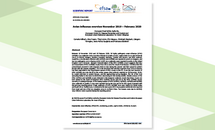Avian influenza overview December 2020 – February 2021
Between 8 December 2020 and 23 February 2021, 1,022 highly pathogenic avian influenza (HPAI) virus detections were reported in 25 EU/EEA countries and the UK in poultry (n=592), wild (n=421) and captive birds (n=9).
Executive Summary
The majority of the detections were reported by France that accounted for 442 outbreaks in poultry, mostly located in the Landes region and affecting the foie gras production industry, and six wild bird detections; Germany, who reported 207 detections in wild birds and 50 poultry outbreaks; Denmark, with 63 detections in wild birds and one poultry outbreak; and Poland, with 37 poultry outbreaks and 24 wild bird detections.
Due to the continued presence of HPAI A(H5) viruses in wild birds and the environment, there is still a risk of avian influenza incursions with the potential further spread between establishments, primarily in areas with high poultry densities.
As the currently circulating HPAI A(H5N8) virus can cause high mortality also in affected duck farms, mortality events can be seen as a good indicator of virus presence. However, also subclinical virus spread in this type of poultry production system have been reported. To improve early detection of infection in poultry within the surveillance zone, the clinical inspection of duck establishments should be complemented by encouraging farmers to collect dead birds to be pooled and tested weekly (bucket sampling).
Six different genotypes were identified to date in Europe and Russia, suggesting a high propensity of these viruses to undergo multiple reassortment events. To date, no evidence of fixation of known mutations previously described as associated to zoonotic potential has been observed in HPAI viruses currently circulanting in Europe based on the available sequences.
Seven cases due to A(H5N8) HPAI virus have been reported from Russia, all were poultry workers with mild or no symptoms. Five human cases due to A(H5N6) HPAI and 10 cases due to A(H9N2) LPAI viruses have been reported from China.
The risk for the general population as well as travel-related imported human cases is assessed as very low and the risk for people occupationally exposed people as low. Any human infections with avian influenza viruses are notifiable within 24 hours through the Early Warning and Response System (EWRS) and the International Health Regulations (IHR) notification system.
Download

Read more
Risk assessment
Threat Assessment Brief: First identification of human cases of avian influenza A(H5N8) infection
This Threat Assessment Brief considers the risk of infection related to avian influenza A(H5N8) virus to the general population and the occupationally exposed.






